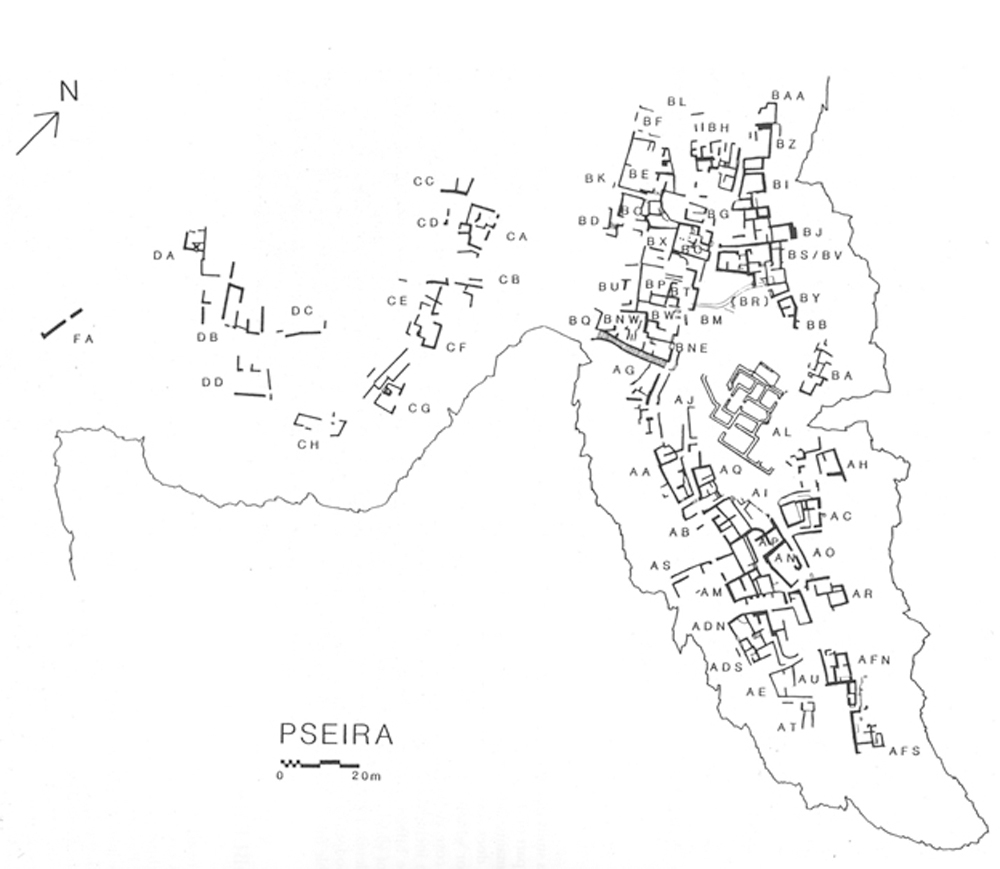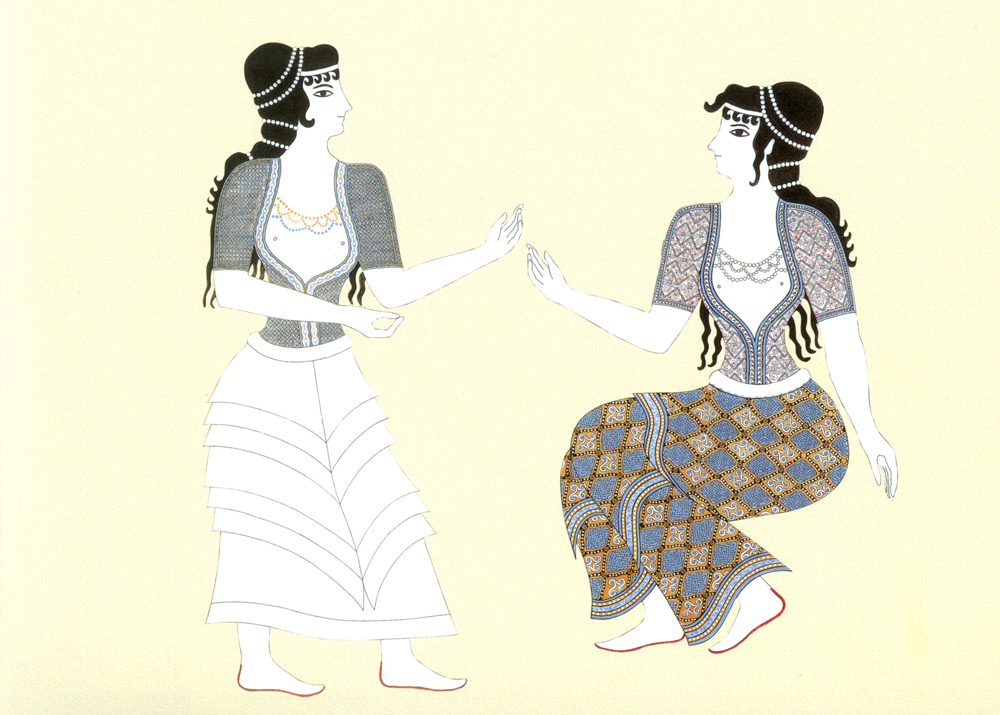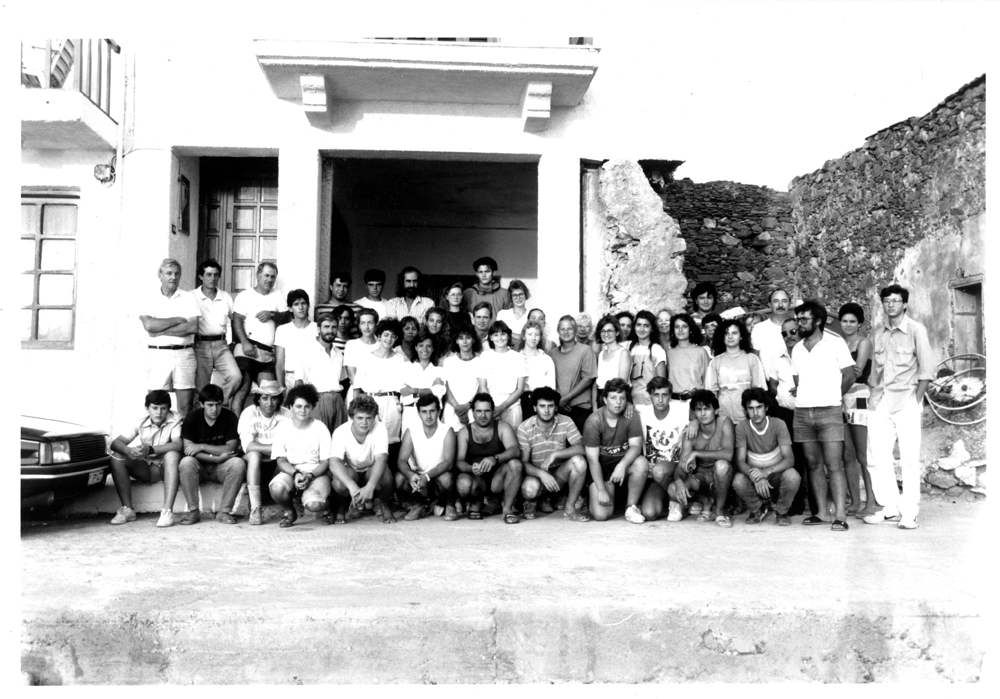Pseira is a small island located on the eastern side of the Gulf of Mirabello. It had substantial settlement in only two historical periods, the Minoan Bronze Age and the Early Byzantine period. The site was first excavated in 1906 and 1907 by Richard Seager, and additional fieldwork was conducted (as a Greek-American synergasia) under the joint direction of Philip P. Betancourt and Costis Davaras starting in 1985.
The island was first settled, on a peninsula that overlooks a natural harbor, in the Final Neolithic period and was occupied until the Middle Minoan (MM) IIB period, when the site was almost completely destroyed. The early settlement was organized around an irregularly shaped open area (plateia) surrounded by buildings on all sides. The inhabitants of this settlement buried their dead in small cist graves, small house tombs, and rock shelters.
In Late Minoan (LM) IA a new town was built, continuing in LM IB; the settlement was expanded, new houses were constructed with a different orientation, and the street system was changed.

Most of the preserved plan dates to this period, and it consists of over 60 buildings set on terraces and divided into blocks by streets and stairs; the buildings themselves varied considerably in both size and design.

Of particular note is Building AC (the “Shrine”) from which were recovered fine painted plaster reliefs depicting two seated female figures with ornate clothing, showing strong Knossian influence in style.

Building BS/BV (the Plateia Building) is the largest structure excavated on the island, is located on the town square, and shows evidence for cult practice and several types of craftwork (e.g., stone vase and other object manufacture, weaving). Late Minoan I Pseira also had sophisticated water management systems, represented by two earth- and stone-built dams located west and south of the settlement.
This prosperous town was violently destroyed at the end of LM IB and was re-inhabited on a limited scale in the LM III period. Pseira was not permanently inhabited again until the Early Byzantine period when a monastery (Building AL) was constructed using stone blocks from the Minoan ruins.
The site of Pseira must be visited by boat. Boats depart from Tholos Beach (of the village of Kavousi) or Mochlos.

Selected References
Betancourt, P.P. 1983. Minoan Objects Excavated from Vasilike, Pseira, Sphoungaras, Priniatikos Pyrgos, and Other Sites. The Cretan Collection in the University Museum, University of Pennsylvania I (University Museum Monograph 47), Philadelphia.
———. 2009. Pseira X: The Excavation of Block AF (Prehistory Monographs 28), Philadelphia.
———. 2012. The Dams and Water Management Systems of Minoan Pseira, Philadelphia.
Betancourt, P.P., and C. Davaras. 1988. “Excavations at Pseira, 1985 and 1986,” Hesperia 57, pp. 207–225. DOI: 10.2307/148354.
———. 2000. “Pseira,” in Crete 2000: One Hundred Years of American Archaeological Work on Crete, J.D. Muhly, ed., Athens, pp. 38–57.
Betancourt, P.P., and C. Davaras, eds. 1995. Pseira I: Minoan Buildings on the West Side of Area A (University Museum Monograph 90), Philadelphia.
———. 1998. Pseira II: Building AC (the “Shrine”) and Other Buildings in Area A (University Museum Monograph 94), Philadelphia.
———. 1999. Pseira IV: Minoan Buildings in Areas B, C, D, and F (University Museum Monograph 105), Philadelphia.
———. 2002. Pseira VI: The Pseira Cemetery 1. The Surface Survey (Prehistory Monographs 5), Philadelphia.
———. 2002. Pseira VII: The Pseira Cemetery 2. Excavation of the Tombs (Prehistory Monographs 6), Philadelphia.
Betancourt, P.P., C. Davaras, and R. Hope Simpson, eds. 2004. Pseira VIII: The Archaeological Survey of Pseira Island. Part 1 (Prehistory Monographs 11), Philadelphia.
———. 2005. Pseira IX: The Archaeological Survey of Pseira Island. Part 2. The Intensive Surface Survey (Prehistory Monographs 12), Philadelphia.
Davaras, C., P.P. Betancourt, and W.R. Farrand. 1992. “Pseira,” in The Aerial Atlas of Ancient Crete, J.W. Myers, E.E. Myers, and G. Cadogan, eds., Berkley, Los Angeles, pp. 262–267.
Floyd, C.R. 1998. Pseira III: The Plateia Building (University Museum Monograph 102), Philadelphia.
McEnroe, J.C. 2001. Pseira V: The Architecture of Pseira (University Museum Monograph 109), Philadelphia.
Seager, R.B. 1910. Excavations on the Island of Pseira, Crete (The Museum Anthropological Publications III.1), Philadelphia.
For further information, see articles in Kentro 12.
